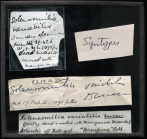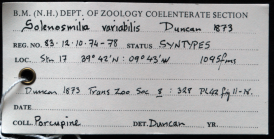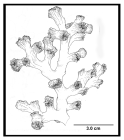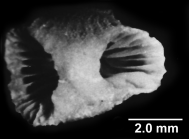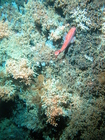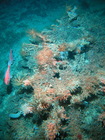RAS taxon details
Solenosmilia Duncan, 1873
135101 (urn:lsid:marinespecies.org:taxname:135101)
accepted
Genus
Solenosmilia variabilis Duncan, 1873 (type by monotypy)
marine, fresh, terrestrial
recent only
Duncan PM. (1873). A description of the Madreporaria dredged up during the Expeditions of H.M.S. 'Porcupine' in 1869 and 1870. <em>Transactions of the Zoological Society of London.</em> 8: 303-344, pls. 39-49. [details]
Hoeksema, B. W.; Cairns, S. (2025). World List of Scleractinia. Solenosmilia Duncan, 1873. Accessed through: RAS (Eds.) (2025) Register of Antarctic Species at: https://ras.biodiversity.aq/aphia.php/www.pfeil-verlag.de/04biol/rest/aphia.php?p=taxdetails&id=135101 on 2025-09-12
RAS (Eds.) (2025). Register of Antarctic Species. Solenosmilia Duncan, 1873. Accessed at: https://ras.biodiversity.aq/aphia.php/www.pfeil-verlag.de/04biol/www.pfeil-verlag.de/04biol/aphia.php?p=taxdetails&id=135101 on 2025-09-12
Date
action
by
original description
Duncan PM. (1873). A description of the Madreporaria dredged up during the Expeditions of H.M.S. 'Porcupine' in 1869 and 1870. <em>Transactions of the Zoological Society of London.</em> 8: 303-344, pls. 39-49. [details]
context source (Hexacorallia) Fautin, Daphne G. (2013). Hexacorallians of the World. (look up in IMIS) [details]
basis of record Cairns, S.D., Hoeksema, B.W., and J. van der Land, 2001. Scleractinia, <B><I>in</I></B>: Costello, M.J. <i>et al.</i> (Ed.) (2001). <i>European register of marine species: a check-list of the marine species in Europe and a bibliography of guides to their identification. Collection Patrimoines Naturels,</i> 50: pp. 109-110 (look up in IMIS) [details]
additional source Veron JEN. (1986). Corals of Australia and the Indo-Pacific. <em>Angus & Robertson Publishers.</em> [details]
additional source Cairns, S.D., R. Baron-Szabo, A.F. Budd, B. Lathuilière, E. Roniewicz, J. Stolarski & K.G. Johnson. (2010). Corallosphere. , available online at http://www.corallosphere.org [details]
additional source Duncan PM (1884) A revision of the families and genera of the sclerodermic Zoantharia, Ed. & H., or Madreporaria (M. Rugosa excepted). Journal of the Linnean Society of London, 18: 1-204. [details]
additional source Keller, N. B.; Naumov, D. V.; Pasternak, F. A. (1975). Bottom deep-sea Coelenterata from the Gulf and Caribbean [In Russian]. Transactions of the Institute of Oceanology, Academy of Sciences of the USSR, 100, 147-159
page(s): 157 [details]
additional source Stetson, T. R.; Squires, D. F.; Pratt, R. M. (1962). Coral banks occurring in deep water on the Blake Plateau. American Museum Novitates, (2114): 1-39
page(s): 34 [details]
redescription Cairns, S.D. (1995). The marine fauna of New Zealand: Scleractinia (Cnidaria: Anthozoa. <em>New Zealand Oceanographic Memoir.</em> 103: 1-210. [details] Available for editors
context source (Hexacorallia) Fautin, Daphne G. (2013). Hexacorallians of the World. (look up in IMIS) [details]
basis of record Cairns, S.D., Hoeksema, B.W., and J. van der Land, 2001. Scleractinia, <B><I>in</I></B>: Costello, M.J. <i>et al.</i> (Ed.) (2001). <i>European register of marine species: a check-list of the marine species in Europe and a bibliography of guides to their identification. Collection Patrimoines Naturels,</i> 50: pp. 109-110 (look up in IMIS) [details]
additional source Veron JEN. (1986). Corals of Australia and the Indo-Pacific. <em>Angus & Robertson Publishers.</em> [details]
additional source Cairns, S.D., R. Baron-Szabo, A.F. Budd, B. Lathuilière, E. Roniewicz, J. Stolarski & K.G. Johnson. (2010). Corallosphere. , available online at http://www.corallosphere.org [details]
additional source Duncan PM (1884) A revision of the families and genera of the sclerodermic Zoantharia, Ed. & H., or Madreporaria (M. Rugosa excepted). Journal of the Linnean Society of London, 18: 1-204. [details]
additional source Keller, N. B.; Naumov, D. V.; Pasternak, F. A. (1975). Bottom deep-sea Coelenterata from the Gulf and Caribbean [In Russian]. Transactions of the Institute of Oceanology, Academy of Sciences of the USSR, 100, 147-159
page(s): 157 [details]
additional source Stetson, T. R.; Squires, D. F.; Pratt, R. M. (1962). Coral banks occurring in deep water on the Blake Plateau. American Museum Novitates, (2114): 1-39
page(s): 34 [details]
redescription Cairns, S.D. (1995). The marine fauna of New Zealand: Scleractinia (Cnidaria: Anthozoa. <em>New Zealand Oceanographic Memoir.</em> 103: 1-210. [details] Available for editors
 Present
Present  Inaccurate
Inaccurate  Introduced: alien
Introduced: alien  Containing type locality
Containing type locality
